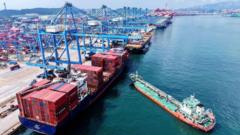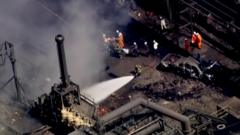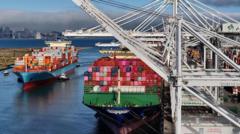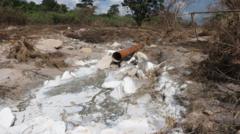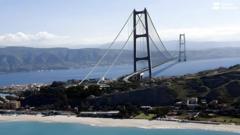Australia is making a substantial move to counter China's dominance in the rare earth market by leveraging its own rich stockpile of critical minerals. With a billion-dollar loan to Iluka Resources, the government aims to build a refinery to process these essential materials, which are vital for technologies ranging from electric vehicles to national defense. This venture not only seeks to secure a localized supply chain but also aims to provide a sustainable alternative to uncontested supplies from China while addressing environmental concerns linked to rare earth processing.
**Australia's Ambitious Plan to Break China's Rare Earth Monopoly**
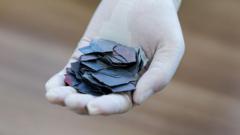
**Australia's Ambitious Plan to Break China's Rare Earth Monopoly**
Australia ventures into the rare earths sector with a massive investment to ensure supply chain independence from China.
In a remote area three hours north of Perth lies Eneabba, a seemingly barren land that conceals a hidden treasure — a million-tonne stockpile of rare earths critical for contemporary technologies, particularly in the green energy and defense sectors. Recognizing the strategic importance of these materials, the Australian government recently allocated a billion-dollar loan to Iluka Resources, a mining company, to extract and refine these elements, thereby aiming to disrupt China's longstanding monopoly in the industry.
China currently controls over half of the global rare earth mining and nearly 90% of processing. This monopoly has become particularly concerning for Western nations, especially in light of recent trade disputes and supply chain disruptions prompted by geopolitical tensions. "The West dropped the ball – that’s the reality," states Jacques Eksteen, chair for extractive metallurgy at Curtin University, highlighting the urgency of Australia’s new initiative.
Rare earth elements, although not actually rare, are essential for various components in electric vehicles and other advanced technologies. The elemental familiarities create complex challenges in separating these materials, requiring extensive refining processes that also pose environmental hazards. However, Iluka’s existing stockpile — accumulated over years of mining zircon — is now seen as a significant asset worth over $650 million, prompting the government to invest heavily in the sector.
This investment aligns with a broader strategy to create a secure and sustainable supply chain of rare earths. "We expect to be able to supply a significant proportion of Western demand for rare earths by 2030," said Dan McGrath, head of rare earths at Iluka. Nevertheless, environmental considerations loom large, as critics point out that while building an industry in Australia offers cleaner practices compared to China's mining and processing methods, the production still has to contend with hazardous waste and regulatory challenges.
As nations like the EU have attempted to spotlight China's monopolistic practices, Australia’s proactive approach aims not only at self-sufficiency but also at appealing to international markets wary of dependence on a single supplier. "We can either sit back and let things happen or take responsibility for developing a competitive rare earths industry in Australia," declared Madeleine King, Australia’s resources minister.
In conclusion, while the road ahead for Australia’s rare earths venture is fraught with challenges — from the complexity of processing to potential pollution issues — the country is positioning itself as a viable and responsible alternative to China, hoping to foster a more resilient international supply chain in critical minerals.
China currently controls over half of the global rare earth mining and nearly 90% of processing. This monopoly has become particularly concerning for Western nations, especially in light of recent trade disputes and supply chain disruptions prompted by geopolitical tensions. "The West dropped the ball – that’s the reality," states Jacques Eksteen, chair for extractive metallurgy at Curtin University, highlighting the urgency of Australia’s new initiative.
Rare earth elements, although not actually rare, are essential for various components in electric vehicles and other advanced technologies. The elemental familiarities create complex challenges in separating these materials, requiring extensive refining processes that also pose environmental hazards. However, Iluka’s existing stockpile — accumulated over years of mining zircon — is now seen as a significant asset worth over $650 million, prompting the government to invest heavily in the sector.
This investment aligns with a broader strategy to create a secure and sustainable supply chain of rare earths. "We expect to be able to supply a significant proportion of Western demand for rare earths by 2030," said Dan McGrath, head of rare earths at Iluka. Nevertheless, environmental considerations loom large, as critics point out that while building an industry in Australia offers cleaner practices compared to China's mining and processing methods, the production still has to contend with hazardous waste and regulatory challenges.
As nations like the EU have attempted to spotlight China's monopolistic practices, Australia’s proactive approach aims not only at self-sufficiency but also at appealing to international markets wary of dependence on a single supplier. "We can either sit back and let things happen or take responsibility for developing a competitive rare earths industry in Australia," declared Madeleine King, Australia’s resources minister.
In conclusion, while the road ahead for Australia’s rare earths venture is fraught with challenges — from the complexity of processing to potential pollution issues — the country is positioning itself as a viable and responsible alternative to China, hoping to foster a more resilient international supply chain in critical minerals.

